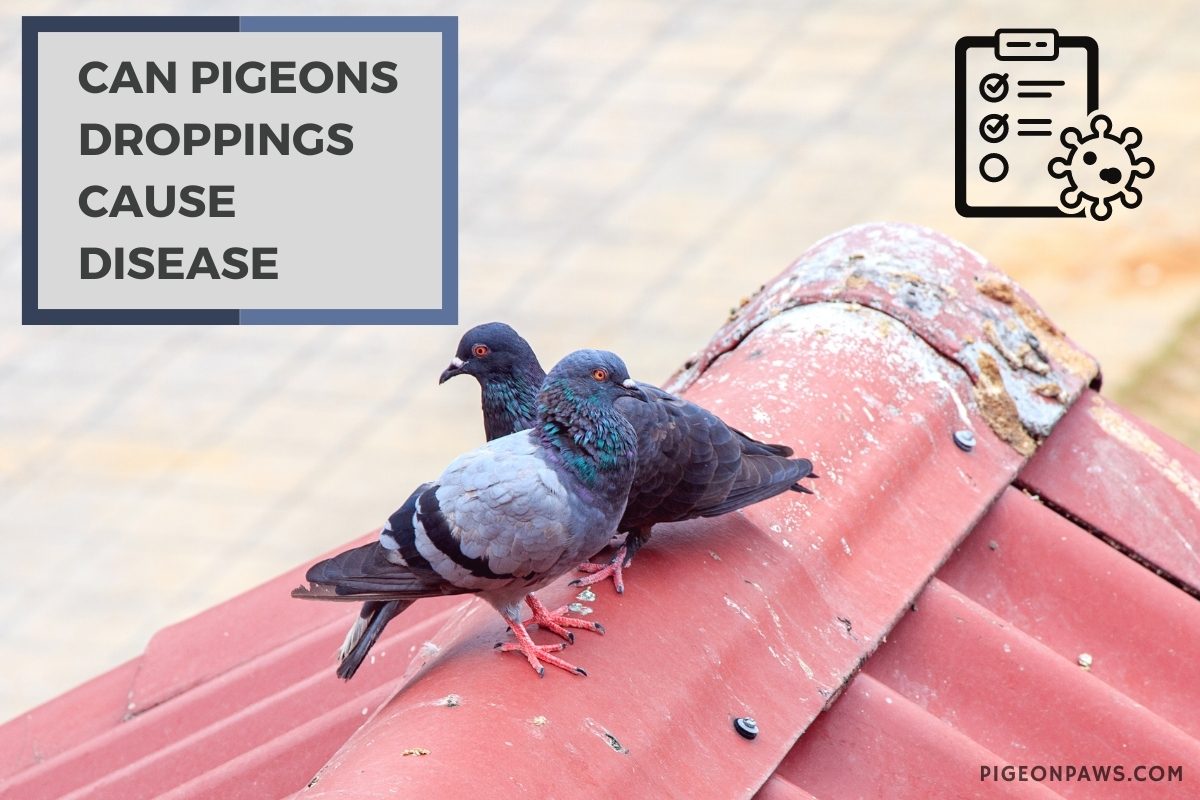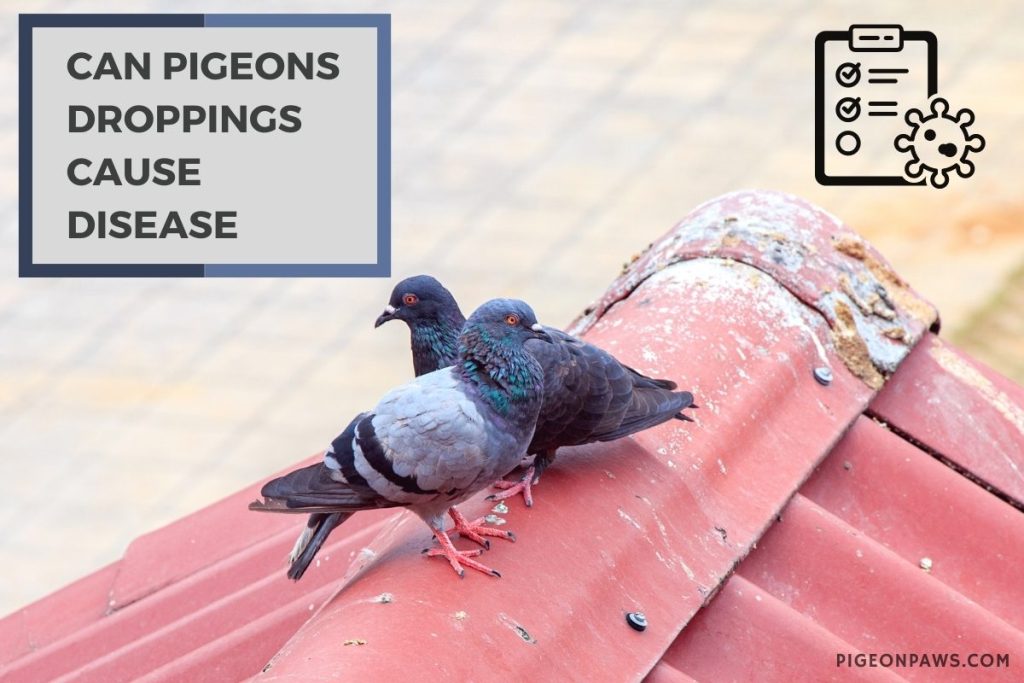Can Pigeons Droppings Cause Disease? The Hidden Dangers

Pigeons have been a common sight in cities for centuries, but did you know that their droppings can be a health hazard?
Yes. Pigeon droppings have the potential to spread a range of diseases, such as histoplasmosis, salmonellosis, and E. coli. Humans may become exposed to these diseases through inhalation, contact with contaminated surfaces, or ingestion. Aside from health risks, droppings can also cause structural damage to buildings.
If you’re interested in learning more about the dangers of pigeon droppings and how to prevent them, keep reading. I’ll discuss the various diseases associated with pigeon droppings, how they spread, and the steps you can take to protect yourself and your environment.

What Are The Diseases Caused by Pigeon Droppings?
Have you ever been walking outside and looking up to see what looks like a million pigeons flying overhead? We all know that these birds can be a nuisance. As we said before, pigeon droppings can also be hazardous to your health as they can cause a variety of diseases. Here are some of them.
Histoplasmosis
Histoplasmosis is a fungal infection caused by inhaling fungal spores from pigeon droppings. These fungal spores can cause respiratory symptoms, including fever, cough, and chest pain. In severe cases, the infection can spread to other parts of the body and cause more serious symptoms.
Psittacosis
Psittacosis, also known as parrot fever, is a bacterial infection caused by inhaling dust or dried droppings from infected birds, including pigeons. This disease can cause flu-like symptoms, such as fever, headache, and muscle pain, and can lead to pneumonia in severe cases.
E. coli And Salmonella
Pigeon droppings can also carry dangerous bacteria, including E. coli and Salmonella, which can cause food poisoning and other illnesses if ingested. These bacteria can be spread through contaminated food and water, as well as by direct contact with droppings.
Cryptococcosis
Cryptococcosis is another fungal infection acquired from inhaling the fungus on old and dry bird droppings, with those with weakened immune systems particularly at risk. Symptoms of this infection are often mild and may include fever, headache, and fatigue.
In more severe cases, neurological symptoms may occur and even lead to death if left untreated. It is treated with antifungal medications.
How Can Exposure to Pigeon Droppings Lead to Illness?
The buildup of droppings can create an environment ideal for the growth and spread of dangerous pathogens and bacteria. Let’s check out the ways how can pigeon droppings leads to various illness.
Inhaling Contaminated Air
Pigeon droppings release tiny particles into the air, which can be inhaled and cause respiratory issues. This is especially dangerous for those with pre-existing respiratory conditions, such as asthma or COPD.
Skin Contact
Coming into direct contact with pigeon droppings can also lead to illness. The bacteria and fungi present in droppings can cause skin irritation, rashes, and even infections. It’s important to always wash your hands thoroughly after handling pigeon droppings or anything contaminated by them.
Ingesting Contaminated Food Or Water
Pigeon droppings can contaminate food and water sources, leading to the spread of diseases such as E. coli or Salmonella. It’s crucial to properly clean and sanitize any areas where food is prepared or stored to prevent contamination.
Are Pigeons Droppings a Source of Rabies?
Pigeons and rabies: separating fact from fiction. While pigeons are often associated with urban areas and their droppings can be unpleasant, there is no evidence to suggest that they are a source of rabies. Rabies is primarily transmitted through bites from infected animals such as bats, raccoons, or stray dogs. Pigeons are generally considered a low-risk species when it comes to rabies transmission, so it’s important to get the facts straight before jumping to conclusions.
Who Is Most at Risk from These Diseases?
Pigeon droppings can pose a risk to anyone exposed to them, but certain populations are more vulnerable to illness. Some of the groups who are most at risk include:
Children
Children are particularly at risk of diseases caused by pigeon droppings. This is partly due to their weaker immune systems, which makes them more susceptible to infection. Additionally, children tend to spend more time outdoors and in playgrounds, which are areas that are more likely to be populated with pigeons.
People with Weakened Immune systems
Those with chronic illnesses or compromised immune systems, such as those undergoing chemotherapy, are at a higher risk of developing illnesses from exposure to pigeon droppings.
The Elderly
The elderly are among those most at risk from these diseases, as their immune systems are generally weaker and less able to fight off infections. Other groups at risk of these illnesses include those with underlying medical conditions, such as diabetes, heart disease, or asthma, and those with weakened immune systems due to medications, chemotherapy treatments, or other illnesses.
Pregnant Women
Pregnant women are particularly vulnerable to the potential illnesses associated with pigeon droppings, as the diseases can have potentially severe consequences for the mother and the unborn child.
A pregnant woman’s immune system is weakened, leaving her more vulnerable to harmful bacteria, fungi, and viruses found in pigeon droppings. As such, pregnant women must take extra precautions to protect themselves from any exposure to pigeon droppings.
People Who Work With Pigeons
Individuals who work with pigeons, such as pigeon keepers and those who clean up pigeon droppings, are at a higher risk of exposure to diseases associated with working with the birds. This risk is heightened due to the close contact with the birds and their droppings, which can harbor various pathogens which may cause illness.
It is recommended that pigeon keepers, and those who clean up their droppings, practice proper hygiene and safety measures when handling the birds and their waste, such as wearing protective gloves and masks to prevent exposure.
Conclusion
Now you know in detail that pigeon droppings can indeed cause diseases that can be harmful to human health. It’s essential to understand the risk factors and take necessary precautions to avoid exposure to pigeon droppings.
Proper sanitation measures, such as cleaning up droppings regularly, wearing protective gear, and sealing off areas where pigeons nest, can help prevent the spread of diseases caused by pigeon droppings.
Additionally, if you suspect you’ve been exposed, it’s important to seek medical attention promptly. By taking these steps, we can reduce the risk of illness caused by pigeon droppings and ensure a healthy and safe environment for all.

